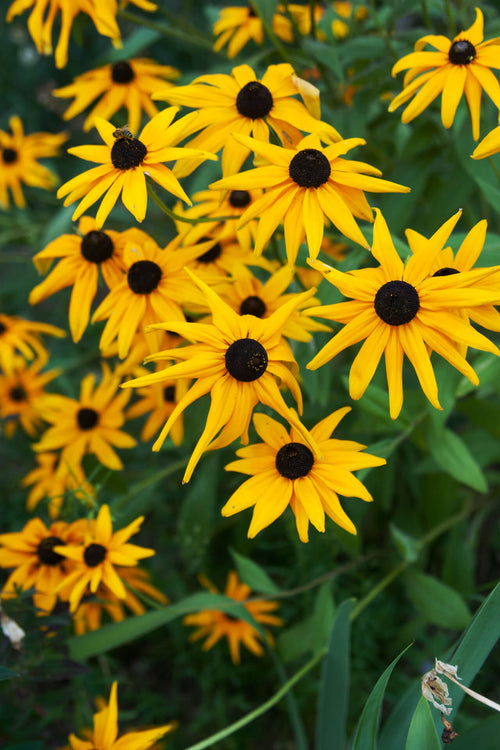Creating a monarch butterfly-friendly garden is a delightful way to add beauty to your outdoor space
It is a vital step in conserving these iconic pollinators.
Monarch butterflies rely on specific plants as their primary food source and for breeding. By incorporating a variety of nectar-rich flowering plants in your garden, you can attract monarchs and provide them with essential resources throughout their lifecycle.
This article will explore the top ten pollinator plants desirable to monarch butterflies, ensuring a thriving and colorful habitat for these majestic creatures.
Milkweed is the cornerstone of any monarch garden. Monarchs exclusively lay their eggs on milkweed, and the larvae feed on their leaves.
Common milkweed (Asclepias syriaca) and butterfly milkweed (Asclepias tuberosa) are popular. Their vibrant flowers provide abundant nectar for adult monarchs, and the plants' toxins make monarchs unpalatable to predators.
Zinnia
Zinnias are colorful annual flowers that produce copious amounts of nectar, attracting monarchs and other pollinators. Choose varieties with single or double flowers in orange, yellow, and red shades.
Zinnias are easy to grow and bloom from summer through fall, providing a consistent food source for adult monarchs.
Coneflower
Coneflowers, such as purple coneflower (Echinacea purpurea), are excellent choices for monarch gardens. These sturdy perennials have daisy-like blooms in purple, pink, and white shades. They produce ample nectar and have a long blooming season, attracting monarchs during their migrations and helping sustain them throughout the summer.
Black-eyed Susan
Black-eyed Susan (Rudbeckia hirta) is a cheerful, native wildflower that thrives in various conditions. It is golden-yellow petals and dark centers create a striking visual appeal. Black-eyed Susans produce abundant nectar, attracting monarchs, other butterflies, and pollinators. They bloom from mid-summer to fall, providing essential nourishment during critical periods.
Liatris, a blazing star or gayfeather, adds vertical interest to the garden with its tall, spiky flower heads. Monarchs are particularly drawn to the abundant nectar reserves of these striking perennials. The purple or white blooms of Liatris spicata and Liatris pycnostachya provide a valuable late-summer food source for adult monarchs before their southern migration.
Joe-Pye Weed
Joe-Pye weed (Eutrochium spp.) is a native perennial that offers both nectar and a substantial height for the monarch garden. Its large, dome-shaped flower clusters in shades of pink or mauve create a magnificent display. The flowers attract monarchs and other butterflies, bees, and hummingbirds.
Joe-Pye weed blooms from mid-summer to early fall, providing a vital food source during monarch migration. Asters are late-blooming perennials that offer a burst of color when many other flowers have faded.
New England aster (Symphyotrichum novae-angliae) and smooth aster (Symphyotrichum leave) are particularly favored by monarchs. Their vibrant purple, pink, or white blossoms provide nectar in late summer and fall, attracting monarchs as they prepare for their long journey to overwintering grounds.
Verbena is a versatile annual or perennial plant that offers an abundance of tiny flowers in clusters. Monarchs are especially attracted to the long-lasting blooms of purple top vervain (Verbena bonariensis) and common vervain (Verbena officinalis).
These flowers benefit adult monarchs, providing ample nectar and a landing platform for feeding and sunning
Goldenrod (Solidago spp.) is a native perennial that adds a bright splash of yellow to the garden. Contrary to popular belief, goldenrod does not cause allergies but is instead a valuable late-season nectar source for monarchs.
Its clusters of small, yellow flowers are beautiful to adult monarchs and various other pollinators. Choose species like showy goldenrod (Solidago speciosa) and stiff goldenrod (Solidago rigida) to support monarchs in the late summer and early fall. Sunflowers are a delight for humans and a favorite of monarch butterflies.
Their large, sunny blooms provide ample nectar and act as landing pads for butterflies. Choose native varieties, such as the prairie sunflower (Helianthus petiolaris), Maximilian sunflower (Helianthus maximiliani), or common sunflower (Helianthus annuus). Sunflowers bloom in late summer and fall, offering a plentiful food source for monarchs before their migration or hibernation.
Conclusion By incorporating a diverse range of plants in your garden that provide both host plants for caterpillars and nectar sources for adult monarchs, you can attract these magnificent butterflies and contribute to their conservation.
Creating a monarch-friendly habitat enriches your garden and supports the survival of these enchanting pollinators for generations to come
Tn Nursery https://www.tnnursery.net



















































